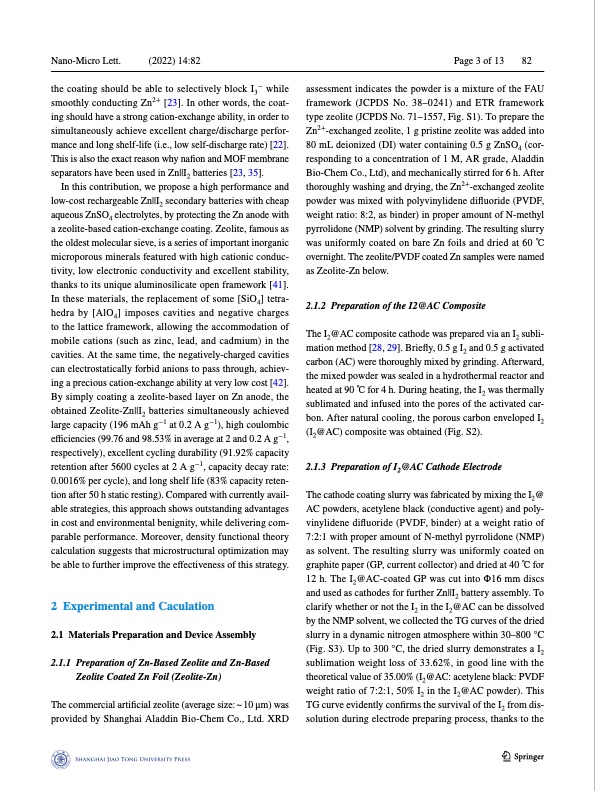
PDF Publication Title:
Text from PDF Page: 003
Nano-Micro Lett. (2022) 14:82 the coating should be able to selectively block I3− while smoothly conducting Zn2+ [23]. In other words, the coat- ing should have a strong cation-exchange ability, in order to simultaneously achieve excellent charge/discharge perfor- mance and long shelf-life (i.e., low self-discharge rate) [22]. This is also the exact reason why nafion and MOF membrane separators have been used in Zn||I2 batteries [23, 35]. In this contribution, we propose a high performance and low-cost rechargeable Zn||I2 secondary batteries with cheap aqueous ZnSO4 electrolytes, by protecting the Zn anode with a zeolite-based cation-exchange coating. Zeolite, famous as the oldest molecular sieve, is a series of important inorganic microporous minerals featured with high cationic conduc- tivity, low electronic conductivity and excellent stability, thanks to its unique aluminosilicate open framework [41]. In these materials, the replacement of some [SiO4] tetra- hedra by [AlO4] imposes cavities and negative charges to the lattice framework, allowing the accommodation of mobile cations (such as zinc, lead, and cadmium) in the cavities. At the same time, the negatively-charged cavities can electrostatically forbid anions to pass through, achiev- ing a precious cation-exchange ability at very low cost [42]. By simply coating a zeolite-based layer on Zn anode, the obtained Zeolite-Zn||I2 batteries simultaneously achieved large capacity (196 mAh g−1 at 0.2 A g−1), high coulombic efficiencies (99.76 and 98.53% in average at 2 and 0.2 A g−1, respectively), excellent cycling durability (91.92% capacity retention after 5600 cycles at 2 A g−1, capacity decay rate: 0.0016% per cycle), and long shelf life (83% capacity reten- tion after 50 h static resting). Compared with currently avail- able strategies, this approach shows outstanding advantages in cost and environmental benignity, while delivering com- parable performance. Moreover, density functional theory calculation suggests that microstructural optimization may be able to further improve the effectiveness of this strategy. 2 Experimental and Caculation 2.1 Materials Preparation and Device Assembly 2.1.1 Preparation of Zn‐Based Zeolite and Zn‐Based Zeolite Coated Zn Foil (Zeolite‐Zn) The commercial artificial zeolite (average size: ~ 10 μm) was provided by Shanghai Aladdin Bio-Chem Co., Ltd. XRD Page 3 of 13 82 assessment indicates the powder is a mixture of the FAU framework (JCPDS No. 38–0241) and ETR framework type zeolite (JCPDS No. 71–1557, Fig. S1). To prepare the Zn2+-exchanged zeolite, 1 g pristine zeolite was added into 80 mL deionized (DI) water containing 0.5 g ZnSO4 (cor- responding to a concentration of 1 M, AR grade, Aladdin Bio-Chem Co., Ltd), and mechanically stirred for 6 h. After thoroughly washing and drying, the Zn2+-exchanged zeolite powder was mixed with polyvinylidene difluoride (PVDF, weight ratio: 8:2, as binder) in proper amount of N-methyl pyrrolidone (NMP) solvent by grinding. The resulting slurry was uniformly coated on bare Zn foils and dried at 60 °C overnight. The zeolite/PVDF coated Zn samples were named as Zeolite-Zn below. 2.1.2 Preparation of the I2@AC Composite The I2@AC composite cathode was prepared via an I2 subli- mation method [28, 29]. Briefly, 0.5 g I2 and 0.5 g activated carbon (AC) were thoroughly mixed by grinding. Afterward, the mixed powder was sealed in a hydrothermal reactor and heated at 90 °C for 4 h. During heating, the I2 was thermally sublimated and infused into the pores of the activated car- bon. After natural cooling, the porous carbon enveloped I (I @AC) composite was obtained (Fig. S2). 2 2 2.1.3 Preparation of I2@AC Cathode Electrode The cathode coating slurry was fabricated by mixing the I2@ AC powders, acetylene black (conductive agent) and poly- vinylidene difluoride (PVDF, binder) at a weight ratio of 7:2:1 with proper amount of N-methyl pyrrolidone (NMP) as solvent. The resulting slurry was uniformly coated on graphite paper (GP, current collector) and dried at 40 °C for 12 h. The I2@AC-coated GP was cut into Φ16 mm discs and used as cathodes for further Zn||I2 battery assembly. To clarify whether or not the I2 in the I2@AC can be dissolved by the NMP solvent, we collected the TG curves of the dried slurry in a dynamic nitrogen atmosphere within 30–800 °C (Fig. S3). Up to 300 °C, the dried slurry demonstrates a I2 sublimation weight loss of 33.62%, in good line with the theoretical value of 35.00% (I2@AC: acetylene black: PVDF weight ratio of 7:2:1, 50% I2 in the I2@AC powder). This TG curve evidently confirms the survival of the I2 from dis- solution during electrode preparing process, thanks to the 13PDF Image | Boosting Zn Battery by Coating a Zeolite‐Based Cation‐Exchange

PDF Search Title:
Boosting Zn Battery by Coating a Zeolite‐Based Cation‐ExchangeOriginal File Name Searched:
Shang2022_ZnI-Battery.pdfDIY PDF Search: Google It | Yahoo | Bing
CO2 Organic Rankine Cycle Experimenter Platform The supercritical CO2 phase change system is both a heat pump and organic rankine cycle which can be used for those purposes and as a supercritical extractor for advanced subcritical and supercritical extraction technology. Uses include producing nanoparticles, precious metal CO2 extraction, lithium battery recycling, and other applications... More Info
Heat Pumps CO2 ORC Heat Pump System Platform More Info
| CONTACT TEL: 608-238-6001 Email: greg@infinityturbine.com | RSS | AMP |